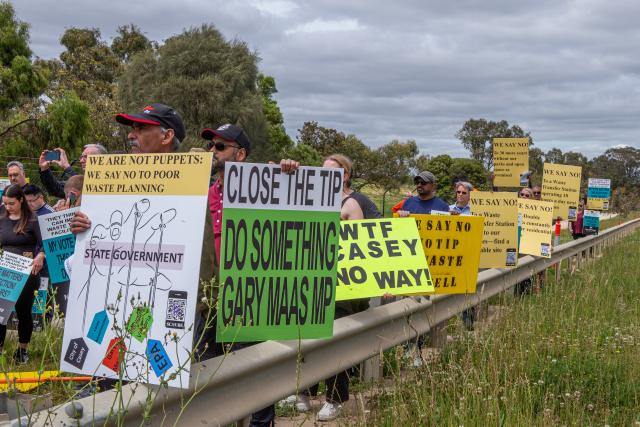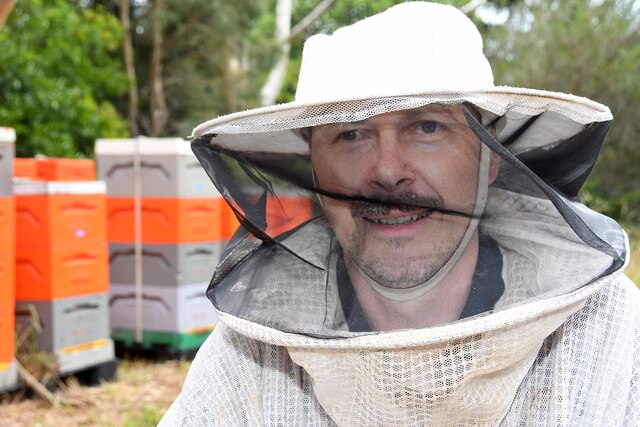Hampton Park locals remain unimpressed with efforts to quell the pungent odour seeping from the Hallam Road landfill.
In an effort to bridge the community divide, the Environmental Protection Authority (EPA) held an informal information session at Lynbrook Community Centre on Tuesday 13 June.
Six tables with a dozen EPA representatives were available for community members to engage with, including odour specialists, landfill specialists, public health officers and permissioning officers.
“My concern is that our child attends a local school that gets impacted by the odour from the tip,“ local resident Chris Lucey said.
“We constantly have to stay inside due to the smell, what is this doing to our long term health, breathing in this toxic stench.“
Residents have claimed mental health distress as a result of the odour, dizziness, nausea, and being unable to enjoy being outdoors at their own homes.
“Veolia doesnt care, its been getting steadily worse since they took over and the EPA take no action,“ Briegh Nish said.
“We call, we lodge reports upon reports of odour and nothing has happened.
“There has been no, real, meaningful or impactful action taken.“
Ms Nish said Hampton Park is “no longer the place for a tip or waste transfer station“.
“The tip needs to close,“ she said.
“Its too densely developed with more and more houses coming.
“It needs be turned into community parkland as promised and waste facilities need to be further away from such densely populated suburbs and their boundaries protected to prevent situations like this in the future.“
Others claim the proximity of residential properties to the landfill was the result of “strategic planning“.
“What we once thought could be rectified by a simple call to the EPA, our plight of a tortuous existence of chronic exposure to harmful landfill gas, so insidious that it fills every room of our homes, and causes misery to every member of our families, we discovered is a result of strategic planning directed by the highest levels of state government and mandated via Sustainability Victoria with the Statewide Waste and Resource Recovery Infrastructure Plan 2018,“ local Dr John Theodoridis said.
Sustainability Victoria (SV) are responsible for the 2018 Statewide Waste and Resource Recovery Infrastructure Plan (SWRRIP) document, which outlines Victoria’s 30-year plan for waste management and responsible landfill operation.
Despite the SWRRIP outlining a proposed system for waste management that “reflects environmental justice principles to ensure that impacts on the community, environment and public health are not disproportionately felt across communities“, SV have said they do not have an active role in waste management in the state.
“As SV doesn’t have a role in the management of landfills we are not in a position to add anything further,“ a Sustainability Victoria spokesperson said.
The EPA issued a remedial notice on 17 February 2023 to improve Veolia’s leachate management, a major contributor to odour emissions.
It requires Veolia to make a series of improvements that must happen by March 2024.
“EPA Victoria has been highly vigilant at Veolia’s Hampton Park site issuing notices that set an enforceable obligation to make improvements,“ said Viranga Abeywickrema, EPA South Metro Region Manager.
“EPA is also continuing its work to identify all sources of odour at the landfill, and to hold Veolia accountable for impacts to local community from odour.
“EPA is undertaking an investigation of Veolia’s landfill gas management to assess whether it is doing everything it can to prevent escape of landfill gas to the local atmosphere and EPA Officers will also undertake an odour monitoring program in residential areas around the landfill.“
With residents routinely reporting health-related issues and concerns, the EPA said they acknowledge the distress, however they are not in a position to focus on individual health outcomes.
“We appreciate the toll odour takes on a community and the distress that it can cause for some,“ Mr Abeywickrema said.
“That’s why we want Veolia to meet its obligation to community by progressing improvements that prevent odour emissions from Hallam Road Landfill as quickly as possible.
“We always recommend that community who experience any health symptoms consult with their health care provider.“
Residents who have been dealing with the odour issue for the decade since it first became an issue are pushing for tangible action to be taken.
The EPA said they will take “further action“ if Veolia continues to breach the terms of their operating licence.
“Again, we would like to see things happen faster, but we are moving as fast as the legal framework allows.“
A Veolia spokesperson said the company’s priority is to “protect the local community and environment“.
“Through best practice waste management, and our commitment to engagement, we follow strict government guidelines to ensure people and the planet are safeguarded,“ they said.
“As residential properties were built closer to our site over the past 20 years, we actively invested in technology to minimise impacts on neighbours, by installing gas extraction wells and altering the design of our site.“
Veolia said they do not have any control over the extent of the buffer zone between residential properties and the landfill, which opened in 1997 when the required buffer zone was a mere 100 metres.
Currently, the necessary buffer zone for the site as described by the EPA is 250 metres, with a proposed distance of 500 metres.
“We have a longstanding Community Reference Group and are fully aligned with the EPA in their view to address community concerns,“ a Veolia spokesperson said.
“When issues occur, we act quickly and immediately to resolve them.
“We remain focused on delivering improvements and providing transparent engagement to our neighbours.”
The City of Casey have also removed themselves as an operating force in the landfill debacle, until the cessation of Veolia’s licence.
“Any concerns about the landfill’s licensing operations relating to pollution and health concerns should be directed to the EPA, who is the appropriate authority to investigate and take action on such matters,“ Manager Planning and Building, Tania Asper said.
“The EPA applied a 100 metre buffer around the landfill site when it was first established in the early 1990s, and about 15 years later the EPA extended it to a 500 metre buffer.
“Council does not have the ability to modify the EPA buffers.“
The landfill at 270-310 Hallam Road in Hampton Park is one of Victoria’s largest landfills, accepting household waste and solid inert waste from multiple Melbourne councils.
Currently, it receives 10 per cent of all appropriate waste in Victoria that goes to landfill.
The Hampton Park landfill has been a site of tension in the local community for over a decade, with previous owner SITA being given enforceable undertakings in 2011 by the EPA after odour management failed to meet the standard.
In February 2020, the EPA fined Suez Recycling and Recovery $8000 for breaching a licence condition after they failed to prevent offsite odours from the landfill.
Additional infrastructure was added, and after SUez merged with Veolia in 2022, the company said they were adhering to strict EPA guidelines.
In June 2022, Narre Warren South’s Lindsay Bartlett said the sewage-like odour from the tip had become so strong it caused him to have an asthma attack.
At the same time, John Tomkins said he toxic stench had become so bad “you couldn’t breathe“.
In September 2022, Lynbrook local Ray Dalli said he expected the value of his home to plummet as he found himself within the buffer zone of the proposed Hallam Road site development plan.
Berwick MP Brad Battin told the State Parliament on 21 September 2022 the City of Casey Hampton Park Hill Development Plan is “not in the interests of local residents“.
“The draft Development Plan has severe repercussions for residents, including significantly reducing the value of their homes and quality of life,“ he said.
Karen Young, who lives on Hallam Road, shared her concern over the proposal for a future waste transfer station at the landfill site.
She fears the trucks running down Hallam Road, particularly after midnight, will create noise pollution the local community is not accustomed to.
“This one is just too big to ignore,“ she said.
Ms Asper said the draft plan is not a proposal to extend the life of the landfill at the site, which has a permit to operate until 2040.
“The landfill is currently filling its final cells and rehabilitation work at this site is expected to start within the next 10 years, over which time that area will be progressively turned into a public open space,“ she said.
“Any future proposed transfer station is likely to be an enclosed design to reduce off-site impacts of noise, dust and smell and will be subject to Council approval through a planning permit application process.
“Following lodgement of the application, traffic impact and other matters will be considered as part of the assessment process.“
Other local politicians join Battin in standing behind the residents affected by the landfill.
“I think it comes down to property rights,“ local Liberal Democratic Party Member Stephen Matulec said.
“If people buy property and then it devalues the property, I think it’s very unfair.
“It could have a massive impact on property prices if they want to move.“
South East Metropolitan MP David Limbrick said there is “no doubt“ the smell is “impacting on the quality of life for local residents“.
“The EPA has been encouraging residents to submit odour reports so that they can track what’s happening,“ he said.
“The bigger picture is that it might be possible in the future to drastically reduce landfill requirements by using waste to energy technology.
Mr Limbrick said he would encourage the council to start talking to the State Government about waste to energy solutions.
“The Government needs to quickly approve waste to energy facilities so that it will be possible to eventually phase out landfills altogether,“ he said.
Veolia will be responsible for the restoration of the land and environment for a period of up to 30 years after its closure.







